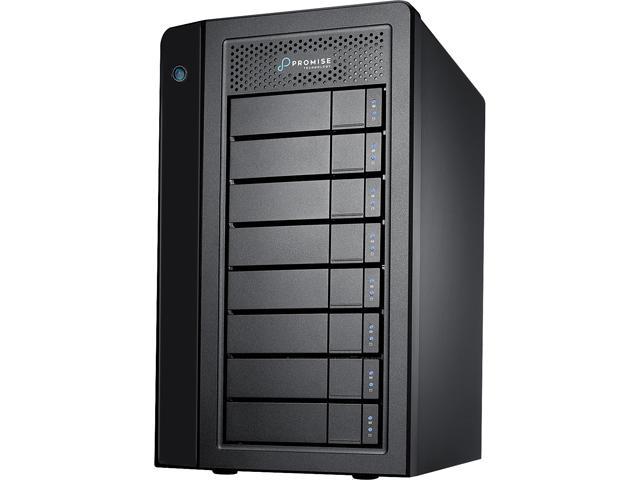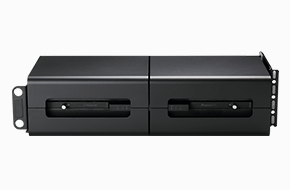The latest generation of Pegasus RAID storage, PROMISE Pegasus3 delivers the power of Thunderbolt 3 technology to Mac users. Now you can get the blazing speeds essential for your high-resolution video and rich media projects, along with the safety and security of full-featured RAID protection.
Dual Thunderbolt 3 ports give you 40 Gbps connectivity and the ability to connect up to six daisy-chained devices on a single Thunderbolt 3 port.
Pegasus3 is ready to use out-of-the-box. It's available in 4-, 6-, and 8-drive versions and includes setup, management, and monitoring tools, as well as a three-year limited warranty and 24/7 online assistance for creative users.
Fast Thunderbolt 3 hardware RAID storage for demanding Mac Users
Up to 40 Gbps port speed—twice the speed of Thunderbolt 2 and four times the speed of USB 3.1
Dual Thunderbolt 3 ports allow up to six daisy-chained devices
Ideal for 4K and high-resolution video editing and creative workflows
Choice of raw capacities: 32TB (28TB pre-configured RAID 5, formatted with HFS+) or 48TB of (42TB pre-configured RAID 5, formatted with HFS+)
Advanced RAID engine supports RAID 0, 1, 5, 6, 10
Backward compatible with Thunderbolt 2 Macs using Apple Thunderbolt 3 to Thunderbolt 2 adapter*
32TB capacity model has eight 4TB drives; 48TB capacity model has eight 6TB drives
Quick start card
Other Features: Kensington Port, RAID support, Time Machine compatible, Upgradeable / Expandable
Power Source: External power supply
Length: 7.3 in./18.54 cm
Weight: 24.2 lb./11 kg
Part Number
Warranty
Note: Products sold through this website that do not bear the Apple Brand name are serviced and supported exclusively by their manufacturers in accordance with terms and conditions packaged with the products. Apple's Limited Warranty does not apply to products that are not Apple-branded, even if packaged or sold with Apple products. Please contact the manufacturer directly for technical support and customer service. The documentation and packaging for this product is in English.
Manufacturer Note
Mac Models
- MacBook Air (Retina, 13-inch, 2018 and later)
- iMac (Retina 4K, 21.5-inch, 2017)
- iMac (Retina 5K, 27-inch, 2017)
- Promise Pegasus 3 R8 To Mac Pro Tower Instruction Manual Free
- Promise Pegasus 3 R8 To Mac Pro Tower Instruction Manual Pdf
- Promise Pegasus 3 R8 To Mac Pro Tower Instruction Manual Download
- Promise Pegasus 3 R8 To Mac Pro Tower Instruction Manual 2017
The Perfect NAS Storage Solution For Small Workgroups. J630 Expansion Storage 48TB with lightning fast speeds.
- Pros
Internal power supply. Little to no setup required. Supports daisy-chaining other Thunderbolt 3 devices. Lightning-quick file transfer times.
- Cons
Does not boast class-leading throughput.
- Bottom Line
One of just a few options for Mac-formatted external RAID arrays, the Promise Pegasus3 R4 is a good choice if you need to store mountains of data and access it quickly.
For most consumers, shopping for an external hard drive involves trading speed for storage capacity. Solid-state drives (SSDs) read and write data much quicker than conventional spinning drives, but their high cost keeps their storage size on the low side. While the Promise Pegasus3 line of drives certainly aren't cheap (the 12TB version we tested costs $1,499), they pack in way more storage than you're going to see in a consumer-grade SSD. And, by combining multiple spinning drives into RAID arrays that connect to your Mac or PC via a Thunderbolt 3 cable, they offer comparable throughput to an SSD. Video editors and others with mountains of often-accessed data will find them to be a worthwhile investment.
- $3,999.00
- $1,199.00
- $749.00
- $3,599.99
- $419.99
- $249.99
- $349.99
Bulky, but Easy to Set Up
We tested the entry-level Mac-specific Pegasus3 R4, which costs $1,499 and features four 3TB drives spinning at 7,200RPM. There are also 24TB and 48TB versions that cost up to $5,000. They're housed in a bulky, black, rectangular enclosure that measures 7.5 by 7.3 by 9.6 (HWD) and weighs 15 pounds. Hiding the enclosure under your desk or in a server closet would do wonders for your office aesthetic, but unfortunately you're limited by the length of the Thunderbolt 3 cable. Promise includes one that measures about 3 feet long, which is small but longer than the sub-1 foot cables that you'll often find bundled with hard drives. The reason for the short length is that Thunderbolt 3 connections are still quite expensive; you won't find a high-quality one that's longer than 3 feet online for much less than $30.
The front of the enclosure features the drive access doors. You can disengage the locking mechanism for each one and remove the drive sleds without any tools, which will come in handy if you plan to use the drive in the 'Just a Bunch of Disks' (JBOD) configuration and frequently hot-swap them. The front also includes the power button, although you won't need to press it since the Pegasus3 automatically turns on whenever you plug the Thunderbolt 3 cable into your Mac. Around the back, you'll find not one, but two exhaust outlets to handle the copious amount of heat that five spinning disks generate. During testing, the fan noise was audible—but not annoying—even in the crowded and noisy PC Labs.

Promise Pegasus 3 R8 To Mac Pro Tower Instruction Manual Free
The rear of the enclosure is also home to the power port, two Thunderbolt 3 connectors, and a Kensington lock slot. The lock slot makes it harder to steal the enclosure, but a thief interested in your data can easily remove the drives from the front. Since the Pegasus3 includes an internal power supply, there's no bulky AC adapter to deal with. Finally, the second Thunderbolt 3 port comes in handy if you have additional peripherals but your MacBook Pro is short on available ports; the Pegasus3 can daisy-chain up to six devices.
Setup can be very simple or relatively complicated, depending on your plans for the drive. If you're just planning on using it to boost storage for your Mac, there's no software setup required; all you need to do is plug it in and the computer will instantly recognize it. But if you'd like to reconfigure the RAID settings or access any other advanced features, you'll need to download the latest version of the Pegasus software utility from the company's website.
Likewise, if you bought the Mac version of the drive (which comes preformatted for the HFS+ file system) and need to connect it to a Windows machine, you'll need to download the Windows version of the software to reformat the drives. Promise also sells a Windows version of the drive that's preformatted for the NTFS file system. It's a good idea to install the software even if you don't plan on changing any settings, since it displays the status of the RAID's logical drive synchronization, which starts automatically but took nearly an hour to complete on our review unit. An unsynchronized logical drive could result in reduced performance.
Promise has improved its warranty period since we reviewed the Pegasus2 last year. Pegasus3 units come with three years of protection, which is one year longer than their predecessors, and the industry standard for this class of drives.
Don't Blink While Transferring Files
The default configuration is a RAID 5 array, which distributes data across the four drives in such a way that it's all accessible even if one drive fails. It's more redundant than a RAID 0 configuration and faster than a RAID 1 configuration, but it means you won't be able to use the full 12TB of space (instead, you're limited to 9TB). The Pegasus RAID engine, which you access through the software utility, can also configure the drive to use RAID 0, 1, 6, or 10 setups. Check out our explainer to learn more about the benefits of RAID and the details of each of these configurations.
We left the Pegasus3 in RAID 5 to run our performance tests, both because it's the default and because it will appeal to many users for its balance of speed and redundancy. The drive was extremely quick on our file-transfer test, which involves moving a 1.2GB folder from our MacBook Pro testbed to the external drive. It completed the task in just less than seconds, which is among the fastest times we've recorded from any drive, including SSDs. By comparison, some other non-Thunderbolt 3 spinning drives take more than five times as long, such as the CalDigit Tuff (12 seconds). The previous Pegasus2 R2+ took 12 seconds to transfer the same folder over a Thunderbolt 2 connection, and so did the Editors' Choice LaCie 5big Thunderbolt 2.
The drive was also speedy on our throughput test, which uses the Mac-based Blackmagic software. It recorded a write speed of 667.4MBps and a read speed of 467.2MBps. Those numbers compare favorably with older external RAID arrays that use Thunderbolt 2, such as the G-Technology G-Speed Studio with its 515.9MBps read and 563.9MBps. Still, the Pegasus3 is significantly slower than the highest-throughput RAID array we've tested. That honor goes to the 5big, which boasts a write speed of 881.7MBps and a read speed of 852.6MBps.
A Good Option in a Niche Category
You don't have many options if you're in the market for a cavernous Thunderbolt 3 RAID array to use with a Mac. Only a few models from LaCie and G-Technology offer direct competition to the Promise Pegasus3. Its Thunderbolt 3 connection results in lightning-quick file transfer times, and at 12 cents per gigabyte for the base 12TB version, it's a relative steal despite an MSRP about equal to the Mac to which you plan to connect it. Still, the higher throughput of the LaCie 5big will make that drive more attractive to video editors who work in 4K, who make up a large part of the target market for external RAID arrays.
Promise Pegasus 3 R8 To Mac Pro Tower Instruction Manual Pdf
Promise Pegasus3 R4
Promise Pegasus 3 R8 To Mac Pro Tower Instruction Manual Download

Bottom Line: One of just a few options for Mac-formatted external RAID arrays, the Promise Pegasus3 R4 is a good choice if you need to store mountains of data and access it quickly.
- $749.00
- $1,099.00
- $499.00
- $1,999.00